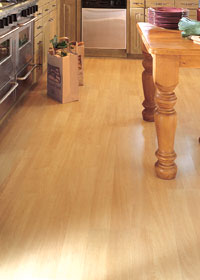Wood
Hardwood is perhaps the most traditional of all floor coverings and today remains one of the most popular. Residential and commercial projects each choose hardwood to achieve casual, professional, modern, antique and many other styles. And every time, hardwood delivers. The benefits of hardwood flooring are many. Hardwoods come in many styles and colors, are affordable, are the top choices for those suffering from allergies, are easy to maintain and are environmentally friendly. Did you know:
- Wood floors increase the value of a home
- Wood flooring should not be waxed, but instead only needs vacuuming or dry-mopping
- Wood flooring increases the air quality of a home because dust particles that typically reside in carpeting can't hide in wood
- Wood flooring comes from carefully harvested timber grown specifically for the industry
Variety of styles
Hardwood comes either pre-finished or unfinished, depending on how much the customer wants to control the end product in terms of color and texture. There are four popular styles of hardwood flooring:
- Natural: Also called “solid,” this style is truly cut from a piece of hardwood lumber into wood planks, using mostly ash, maple, or red or white oak
- Engineered: This method involves gluing several pieces of hardwood together, making them easily manipulated so that flooring can be offered in a variety of colors, textures, and grains. Engineered hardwood is also very durable
- Longstrip: This style is simply a larger version of the engineered variety, but with larger strips or pieces of hardwood included. Longstrip gives the appearance of a more intricate flooring pattern, while in reality an entire section is present on one board
- Exotic: Called exotic because the wood does not originate in North America, this style is mostly the engineered variety and comes in a range of colors and styles
- Handscraped: Also called “sculpted,“ this variety gives a floor an antique look but, in reality, it possesses a modern finish. Handscraped wood is available in solid or engineered varieties.
Selecting the floor for your location
Not all hardwood floor varieties are ideal for all levels of a home or commercial building. For instance, solid hardwood does not do well when placed over concrete or below ground level because its characteristics can change based on environmental conditions such as humidity and moisture. Conversely, engineered hardwood styles can be used over concrete because they withstand humidity and moisture, making them a good choice for basements.
Thinking about the “finished” product
One of the best assets of hardwood flooring is the new finishes available that remove the need for waxing. When choosing hardwood flooring, ask about its finish. Some of the more popular finishes include polyurethane and acrylic-urethane, a chemical that gives hardwood a clear, durable coat and can be put on the wood using water or oil base; or ceramic — using this finish puts a coat on hardwood that allows for more resistance to wear. Pay attention to the finish — hardwood floors with a polyurethane finish should not be waxed, because a sticky film will develop and dirt and dust will stick to the wood’s grain.
Tips for buying a wood floor
Before going to the retailer to purchase your hardwood floor, give some thought to the following:
- Compatibility: Will the style, pattern and texture fit with the environment it will be placed into? Remember that darker colors are used for formal settings, while light colors are usually used in casual environments.
- Performance: Will the finish, wood species and type of floor hold up under the men, women, pets, children, customers and employees who will walk over it every day?
- Cost: After the flooring cost, be sure to consider installation and maintenance costs.
Need more information?
Access the professionalism of the international INSTALL network. Visit the web sites of INSTALL partners:

